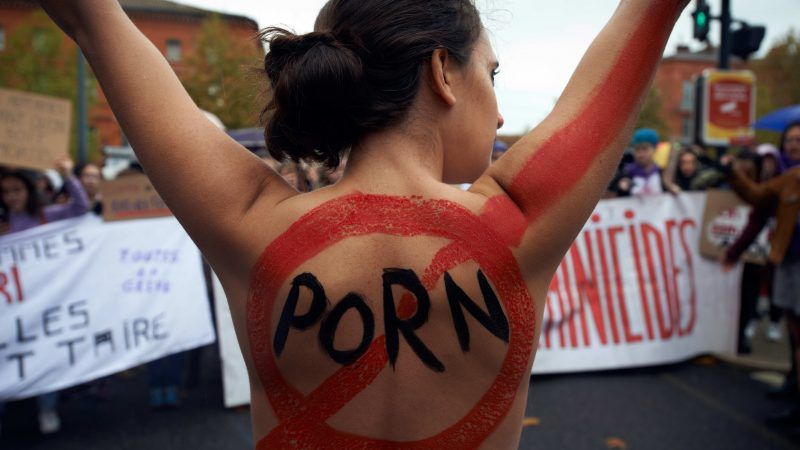5 Myths That Anti-Porn Crusaders Keep Repeating
The porn wars are raging once again!

The porn wars are raging once again, with would-be censors on the right and left trotting out the same tired excuses for suspending the First Amendment—and the same absurd explanations, made even sillier in the digital era, for how a federal porn ban would work.
This round started because four Republican legislators wrote a letter to Attorney General William Barr last week asking for the Department of Justice to make obscenity prosecutions a priority once more.
Let's take a look at some claims from today's porn prohibitionists…
1. Claim: The rise of online pornography and digital marketplaces for sex work has coincided with a rise in violence against women.
In fact, the last several decades have seen decreases in all sorts of violent crime rates, including rates of rape and sexual assault. "Victimization rates for rape in the United States demonstrate an inverse relationship between pornography consumption and rape rates," noted researchers Christopher J. Ferguson and Richard D. Hartley in a 2009 article for the journal Aggression and Violent Behavior reviewing studies on the effects of pornography. And "data from other nations have suggested similar relationships." Overall, "the increasing availability of pornography appears to be associated with a decline in rape."
People who commit rape appear to consume less porn than the general population. In the U.S., rape rates declined faster in states with early internet access. And research has suggested that online "erotic services" marketplaces like Craigslist are directly linked to a decline in female homicide rates. Studies "have also reported positive associations between pornography use and egalitarian attitudes," according to 2015 research from the University of Western Ontario.
2. Claim: Teens who watch porn are more likely to engage in sexually risky behaviors.
In fact, the proliferation of online porn and minors' easy access to it has coincided with a significant drops in just about every negative outcome connected to young people and sex. Teenagers have been waiting longer before losing their virginity. When they do have sex, they are using condoms and contraception more often. And they are having fewer unintended pregnancies.
In addition, studies dating back more than half a century show that growing up in an atmosphere of sexual repression and shame is more likely to predict anti-social sexual attitudes and actions than is exposure to pornography.
"Exposure to pornography during adolescence had little effect on persons who later became rapists and child molesters," reported the Associated Press in 1970, describing a federal commission's conclusions on the subject. The news agency explained that "sexual deviates generally came from homes where pornography was restricted and sex was never discussed" and that "most deviates had been severely punished as teenagers by their parents when caught with pornographic material."
3. Claim: Online porn is uniquely addictive.
In fact, there's nothing uniquely dangerous about digital porn that's getting people "hooked." People who have an "addiction" to watching online porn appear to suffer from the same lack of self-regulation and other underlying cognitive and psychological issues that affect people with other compulsions or problem attachments.
We shouldn't dismiss or mock those who struggle with compulsive porn consumption any more than we should those trapped in other self-destructive behaviors, but we also shouldn't structure society around catering to such pathologies. That's only asking for the same old problems plus a host of new ones.
4. Claim: Porn desensitizes men to regular sex.
In fact, we don't have much research on this—what we do have suggests the opposite. When the UCLA neuroscientist Nicole Prause studied the subject, she found no relationship between porn consumption and erectile dysfunction. And contrary to popular claims, Prause found that watching porn did not make men "unable to respond sexually to 'normal' sexual situations with a partner."
Prause's study, published in 2015 in the journal Sexual Medicine, concluded that the "oft-repeated link" between porn and poor penis functioning is "perpetuated by data-poor literature."
5. Claim: Legal porn increases human trafficking.
In fact, previous bouts of prohibition have shown us that making something illegal doesn't actually stop that thing from existing—but it does make engaging with the banned thing more dangerous for all involved. Porn production and distribution would still happen in an America where online porn was banned. But organized crime would have much more control over it, performers would not have the standard legal protections against violence and exploitation, and it would be harder to prevent the production of porn involving minors or others who cannot or did not consent.
As in all sexual matters, the line between legal and illegal pornography should turn on the willing participation of those involved, not the tastes of whoever shouts the loudest.
The internet has fueled a resurgence in a once-dormant porn panic. But the internet hasn't just enabled more porn access; it has allowed a much more diverse porn landscape, one that features more diverse body types and sexualities and where independent adult entertainers and content creators have more control over their income, image, and work conditions than ever before. There's still much room for improvement, but declaring a new war on obscenity would only set that work back.


Show Comments (115)